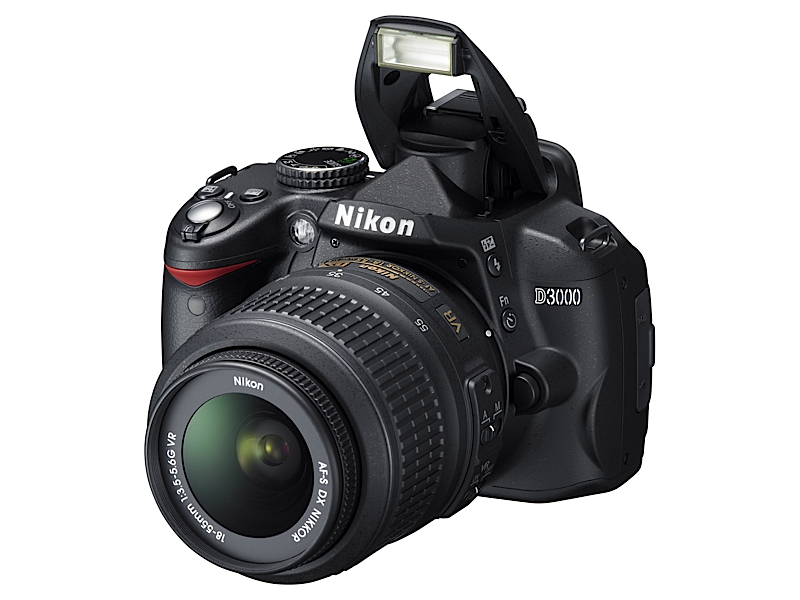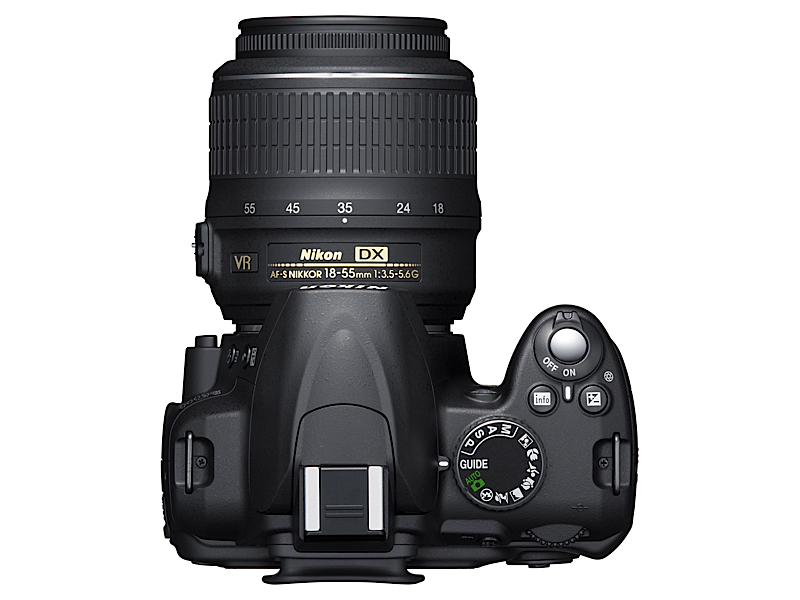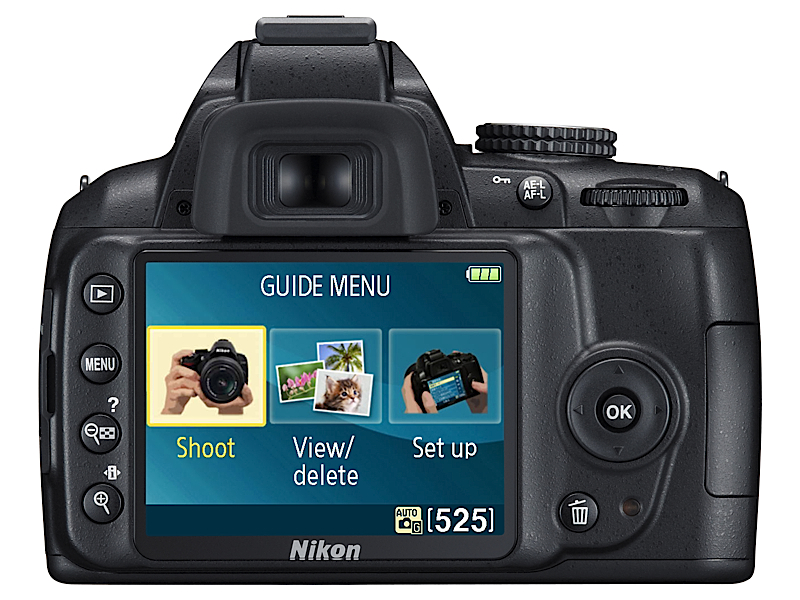Nikon D3000 entry-level DSLR with tutoring Guide mode
It's not just Nikon's flagship D300S new today; the company has also unveiled an entry-level DSLR, the Nikon D3000, aimed at getting new photographers addicted. The 10.2-megapixel camera uses an 11-point autofocus system, DX-format sensor and EXPEED image processing, but the most interesting feature for beginners will be the Guide mode. Not just an automatic setup, Guide mode promises to explain why different settings should be chosen; yes, that's right, it's a teacher trapped inside your DSLR.
Elsewhere there's a 3-inch 230k-dot LCD preview display, scene recognition system, 3fps shooting and Active D-Lighting for better balancing shadows and highlights. There are also some in-camera photo editing tools, including a "Miniature" effect which sounds like it will create pseudo tilt-shift scenes out of your normal shots.
Most importantly, the D3000 is compatible with all of Nikon's NIKKOR AF-S and AF-I lenses, meaning any you buy to go with your first DSLR will still be useful when you inevitably upgrade to the D300S. The Nikon D3000 is priced at$600.
Press Release:
Digital SLR Camera Nikon D3000July 30, 2009
New, intuitive Guide mode and extraordinary 10.2-megapixel image quality provide first-time users with an ideal way to experience the world of digital SLR photography.
Tokyo — Nikon Corporation is pleased to announce the newest addition to its family of quality DX-format digital SLRs, the D3000. Combining in-camera assistance and supreme ease-of-use with Nikon's renowned technology, the D3000 is the ideal choice for people looking to upgrade from their point-and-shoot camera to a digital SLR.
The D3000 features a new Guide mode — a hassle-free way for less-experienced picture-takers to master the capabilities of digital SLR cameras. Through its intuitive user-friendly interface, Guide mode assists users in choosing shooting modes for a variety of situations and, if they choose, in exploring advanced photographic techniques. From close-ups and landscapes to portraits with soft backgrounds and picture-taking opportunities of fast-moving action, Guide mode eases users into the world of digital SLR photography. In addition, settings made with Guide mode can even be fine-tuned before the shot in order to achieve the best possible photos.
Despite its simple interface, the D3000 delivers exceptional picture quality. Thanks to 10.2 effective megapixels, Nikon's DX-format CCD sensor, exclusive EXPEED image processing system, and compatibility with an extensive selection of legendary NIKKOR lenses, the D3000 produces finely detailed images that can be freely cropped and enlarged while retaining sharpness.
Extending the D3000's excellent performance is Nikon's exclusive Scene Recognition System, Active D-Lighting, continuous shooting up to 3 frames-per-second, advanced 3D Color Matrix Metering II, and 11-point selectable autofocus.
For comfortable viewing when playing back images and retouching photos, the D3000 features a bright 3.0-in., 230k-dot TFT LCD monitor. The large monitor also improves readability of menus thanks to a font size that is 20% larger than that of the D60.
Extensive in-camera image control is available using Nikon's Picture Control System, which allows users to customize key digital image characteristics to suit personal preferences. For additional creative control, the D3000 includes comprehensive in-camera editing functions via its Retouch Menu that enhance photos with a variety of effects — without the need for a computer.
Whether it's grabbing point-and-shoot snapshots or exploiting techniques commonly used by more advanced photographers, the D3000 offers an easy, inviting way to experience the world of digital SLR photography and obtain beautiful pictures.
Nikon D3000 Feature Highlights
New Guide mode
In-camera guidance is provided by new Guide mode, which employs an easy-to-use interface that makes it easy for first-time users to select shooting modes. Additionally, after selecting an item in Guide mode, camera settings can be further adjusted in order to obtain optimal results.
Nikon DX-format CCD sensor; 10.2 effective megapixels
At 10.2 effective megapixels, the D3000 produces high-resolution images that enable beautiful enlargements without loss of sharpness. Normal ISO sensitivity is ISO 100 to 1600. For added shooting versatility, a Hi 1 setting increases sensitivity to ISO 3200.
EXPEED image processing system
The D3000 is equipped with Nikon's EXPEED image processing system. EXPEED realizes excellent resolution, long tonal scale, and superb color while also making possible fast processing of the D3000's advanced imaging functions such as Scene Recognition and Active D-Lighting.
Scene Recognition System
This feature improves accuracy for exposure, white balance, and autofocus by analyzing color and illumination over the entire scene milliseconds prior to shooting. It then adjusts the D3000 accordingly for optimal picture quality.
Active D-Lighting
The D3000 incorporates Nikon's Active D-Lighting function to vastly improve details in the shadows and highlights of high-contrast scenes. Like the Scene Recognition System, Active D-Lighting utilizes the 420-pixel RGB sensor to analyze a scene then adjust exposure to achieve images that closely resemble what the human eye sees. During processing, this function also restores details in the highlight and shadow areas of the image that may have been lost.
11-point AF system with Multi-CAM 1000 autofocus sensor module
Employing 11-point autofocus driven by Nikon's Multi-CAM 1000 autofocus sensor module, the D3000 delivers fast, precise focus over a wide area of the frame. Four versatile AF modes are available: single-point AF for stationary subjects, especially ones that are off-center; dynamic-area AF for moving subjects; auto-area AF when you want the D3000 to automatically determine the proper focus method; and 3D-tracking (11 points) AF for maintaining focus on subjects even if the composition changes.
3.0-in. LCD monitor
Image playback and viewing menus is now easier than ever thanks to the 3.0-in., 230k-dot TFT LCD monitor. The large monitor also results in text size that is 20% larger than on previous Nikon digital SLR cameras.
Picture Control System
The Picture Control System of the D3000 gives users the ability to customize key digital image capture characteristics to suit personal preferences. Six settings are available: Standard, Neutral, Vivid, Monochrome, Portrait, and Landscape.
In-camera photo editing
After shooting, the D3000's photo editing functions allow for in-camera retouching, lessening the need for a computer to enhance or modify images. The D3000 introduces a new Miniature effect under its Retouch Menu that modifies images to look like pictures of miniature models. Each editing function is applied to a copy of the image, with the original left unmodified.
Nikon Integrated Dust Reduction System
Dust reduction is handled by the Nikon Integrated Dust Reduction System. This is a comprehensive solution that reduces generation and accumulation of dust and also provides measures to remove dust. A key element of the solution is the Airflow Control System, which directs dust away from the image sensor. The system also includes an image sensor cleaning function that activates automatically when the D3000 is powered on or off. This vibrates the low-pass filter (located in front of the sensor) to free it from dust.
Superb NIKKOR lenses
The D3000 opens up a wide range of possibilities for dramatic expression thanks to full compatibility with the extensive lineup of NIKKOR AF-S and AF-I lenses. From ultra wide-angle and micro to super telephoto, NIKKOR lenses give users the means to explore their creativity to the fullest.
Nikon D3000 Other Features
Extensive playback options that allow viewing of images one at a time or in batches of 4, 9, and 72 as well as Calendar view that organizes images by shooting date and time. A histogram display is also available that shows exposure data for a magnified area of the image.
Highly durable shutter unit tested to 100,000 cycles.
Long-lasting Rechargeable Li-ion Battery EN-EL9a that provides up to 550 shots per charge. (CIPA standard, with AF-S DX NIKKOR 18-55mm f/3.5-5.6G VR and flash fired at full power once every other shot.)
Built-in flash with a guide number of approx. 12/39 (ISO 100, m/ft., 20°C/68°F) and support for Nikon's i-TTL flash control.
Support for the Nikon Creative Lighting System when using SB-900, SB-600, or SB-400 Speedlights, or the SU-800 Wireless Speedlight Commander.
Compatible with all NIKKOR AF-S and AF-I lenses that have an autofocus motor.
Compatible with the optional Wireless Remote Control ML-L3. There are two shutter release modes available when using the control: Quick Response mode for immediate triggering of the shutter release and Delayed Remote mode, which delays triggering for two seconds.
Viewfinder grid lines that aid in picture composition.
Compatible with SD and SDHC memory cards
Includes Nikon ViewNX image browsing and editing software, which lets you organize, label, and select images as well as perform NEF (RAW) image editing adjustments and conversions.
Photos captured with the D3000 can be used with optional Nikon Capture NX 2 photo-editing software, which features patented U Point® technology and powerful tools for quick and easy photo editing, including enhanced NEF (RAW) Editing.
Nikon Digital SLR Camera D3000 Specifications
Type Type Single-lens reflex digital camera
Lens mount Nikon F mount (with AF contacts)
Effective picture angle Approx. 1.5 x lens focal length (Nikon DX format)
Effective pixels Effective pixels 10.2 million
Image sensor Image sensor 23.6 x 15.8 mm CCD sensor
Total pixels 10.75 million
Dust-reduction system
Image Sensor Cleaning, Airflow Control System, Image Dust Off reference data (optional Capture NX 2 software required)
Storage Image size (pixels) 3,872 x 2,592 [L], 2,896 x 1,944 [M], 1,936 x 1,296 [S]
File format • NEF (RAW)
• JPEG: JPEG-Baseline compliant with fine (approx. 1:4), normal (approx. 1:8), or basic (approx. 1:16) compression
• NEF (RAW) + JPEG: Single photograph recorded in both NEF (RAW) and JPEG formats
Picture Control System Can be selected from Standard, Neutral, Vivid, Monochrome, Portrait, Landscape; selected Picture Control can be modified
Media SD (Secure Digital) memory cards, SDHC compliant
File system DCF (Design Rule for Camera File System) 2.0, DPOF (Digital Print Order Format), Exif 2.21 (Exchangeable Image File Format for Digital Still Cameras), PictBridge
Viewfinder Viewfinder Eye-level pentamirror single-lens reflex viewfinder
Frame coverage Approx. 95% horizontal and 95% vertical
Magnification Approx. 0.8 x (50mm f/1.4 lens at infinity, -1.0 m-1)
Eyepoint 18 mm (-1.0 m-1)
Diopter adjustment -1.7 to +0.5 m-1
Focusing screen Type B BriteView Clear Matte Mark V screen with focus frame (framing grid can be displayed)
Reflex mirror Quick return type
Lens aperture Instant return, electronically controlled
Lens Compatible lenses •AF-S and AF-I NIKKOR: All functions supported
•Type G or D AF NIKKOR without built-in autofocus motor: All functions except autofocus supported. IX NIKKOR lenses not supported.
•Other AF NIKKOR: All functions supported except autofocus and 3D color matrix metering II. Lenses for F3AF not supported.
•Type D PC NIKKOR: All functions supported except some shooting modes.
•AI-P NIKKOR: All functions supported except 3D color matrix metering II.
•Non-CPU: Autofocus not supported. Can be used in exposure mode M, but exposure meter does not function.
Note: Electronic rangefinder can be used if lens has a maximum aperture of f/5.6 or faster.
Shutter Type Electronically-controlled vertical-travel focal-plane shutter
Speed 1/4000 to 30 s in steps of 1/3 EV, Bulb, Time (requires optional Wireless Remote Control ML-L3)
Flash sync speed X=1/200 s; synchronizes with shutter at 1/200 s or slower
Release
Release mode Single-frame, continuous, self-timer, quick-response remote, delayed remote
Frame advance rate Up to 3 fps (manual focus, mode M or S, shutter speed 1/250 s or faster, and other settings at default values)
Self-timer Can be selected from 2, 5, 10, and 20 s duration
Exposure Metering TTL exposure metering using 420-pixel RGB sensor
Metering method •Matrix: 3D color matrix metering II (type G and D lenses); color matrix metering II (other CPU lenses)
•Center-weighted: Weight of 75% given to 8-mm circle in center of frame
•Spot: Meters 3.5-mm circle (about 2.5% of frame) centered on selected focus point
Range (ISO 100, f/1.4 lens, 20°C/68°F) •Matrix or center-weighted metering: 0 to 20 EV
•Spot metering: 2 to 20 EV
Exposure meter coupling CPU
Exposure Modes Auto modes (auto, auto [flash off ]), Scene Modes (Portrait, Landscape, Child, Sports, Close up, Night portrait), programmed auto with flexible program (P), shutter-priority auto (S), aperture-priority auto (A) manual (M)
Exposure compensation -5 to +5 EV in increments of 1/3 EV
Exposure lock Luminosity locked at detected value with AE-L/AF-L button
ISO sensitivity (Recommended Exposure Index) ISO 100 to 1600 in steps of 1 EV. Can also be set to approx. 1 EV above ISO 1600 (ISO 3200 equivalent), auto ISO sensitivity control available
Active D-Lighting Can be selected from On or Off
Focus Autofocus Nikon Multi-CAM 1000 autofocus sensor module with TTL phase detection, 11 focus points (including one cross-type sensor), and AF-assist illuminator (range approx. 0.5 to 3 m / 1 ft. 8 in. to 9 ft. 10 in.)
Detection range -1 to +19 EV (ISO 100, 20°C/68°F)
Lens servo •Autofocus (AF): Single-servo AF (AF-S); continuous-servo AF (AF-C); auto AF-S/AF-C selection (AF-A); predictive focus tracking activated automatically according to subject status
•Manual focus (MF): Electronic rangefinder can be used
Focus point Can be selected from 11 focus points
AF-area modes Single-point AF, dynamic-area AF, auto-area AF, 3D-tracking (11 points) AF
Focus lock Focus can be locked by pressing shutter-release button halfway (Single-servo AF) or by pressing AE-L/AF-L button
Flash Built-in flash Auto, Portrait, Child, Close-up, Night portrait: Auto flash with auto pop-up
P, S, A, M: Manual pop-up with button release
Guide Number Approx. 12/39, 13/43 with manual flash (m/ft, ISO 100, 20°C/68°F)
Flash control •TTL: i-TTL balanced fill-flash and standard i-TTL flash for digital SLR using 420-pixel RGB sensor are available with built-in flash and SB-900, SB-800, SB-600, or SB-400 (i-TTL balanced fill-flash is available when matrix or center-weighted metering is selected)
•Auto aperture: Available with SB-900, SB-800 and CPU lens
•Non-TTL auto: Supported flash units include SB-900, SB-800, SB-80DX, SB-28DX, SB-28, SB-27, and SB-22S
•Range-priority manual: Available with SB-900 and SB-800
Flash mode Auto, auto with red-eye reduction, fill-flash, auto slow sync, auto slow sync with red-eye correction, and rear curtain with slow sync
Flash compensation -3 to +1 EV in increments of 1/3 EV
Flash-ready indicator Lights when built-in flash or optional flash unit such as SB-900, SB-800, SB-600, SB-400, SB-80DX, SB-28DX, or SB-50DX is fully charged; blinks for 3 s after flash is fired at full output
Accessory shoe ISO 518 hot-shoe with sync and data contacts and safety lock
Nikon Creative Lighting System (CLS) Advanced Wireless Lighting supported with SB-900, SB-800, or SU-800 as commander; Flash Color Information Communication supported with built-in flash and all CLS-compatible flash units
Sync terminal Sync Terminal Adapter AS-15 (optional)
White balance White balance Auto, incandescent, fluorescent (7 types), direct sunlight, flash, cloudy, shade, preset manual, all except preset manual with fine turning.
Monitor LCD monitor 3-in., approx. 230 k-dot TFT LCD with brightness adjustment
Playback Playback function Full-frame and thumbnail (4, 9, or 72 images or calendar) playback with playback zoom, playback of stop-motion movies created with D3000, slide show, histogram display, highlights, auto image rotation, and image comment (up to 36 characters)
Interface USB Hi-Speed USB
Audio video output Can be selected from NTSC and PAL
Supported languages Supported languages Chinese (Simplified and Traditional), Danish, Dutch, English, Finnish, French, German, Italian, Japanese, Korean, Norwegian, Polish, Portuguese, Russian, Spanish, Swedish
Power source Battery One Rechargeable Li-ion Battery EN-EL9a
AC adapter AC Adapter EH-5a; requires Power Connector EP-5 (optional)
Tripod socket Tripod socket 1/4 in. (ISO 1222)
Dimensions/Weight Dimensions (W x H x D) Approx. 126 x 97 x 64 mm (5.0 x 3.8 x 2.5 in.)
Weight Approx. 485 g (1 lb. 1.1 oz.) without battery, memory card, or body cap
Operating environment Temperature 0 to 40°C (32 to 104°F)
Humidity Less than 85% (no condensation)
Accessories Supplied accessories (may differ by country or area) Rechargeable Li-ion Battery EN-EL9a , Quick Charger MH-23, Eyepiece Cap DK-5, Rubber Eyecap DK-20, USB Cable UC-E4, Camera Strap AN-DC3, Accessory Shoe Cover BS-1, Body Cap BF-1A, Software Suite CD-ROM
Microsoft and Windows are either registered trademarks or trademarks of Microsoft Corporation in the United States and/or other countries.
Macintosh is a registered trademark or a trademark of Apple Inc. in the United States and/or other countries.
The SD logo is a trademark of the SD Card Association.
The SDHC logo is a trademark.
PictBridge is a trademark.
HDMI, the HDMI logo and High-Definition Multimedia Interface are trademarks or registered trademarks of HDMI Licensing LLC.
Products and brand names are trademarks or registered trademarks of their respective companies.
Images in viewfinders, on LCDs and monitors shown in this brochure are simulated.
Specifications and equipment are subject to change without any notice or obligation on the part of the manufacturer.



